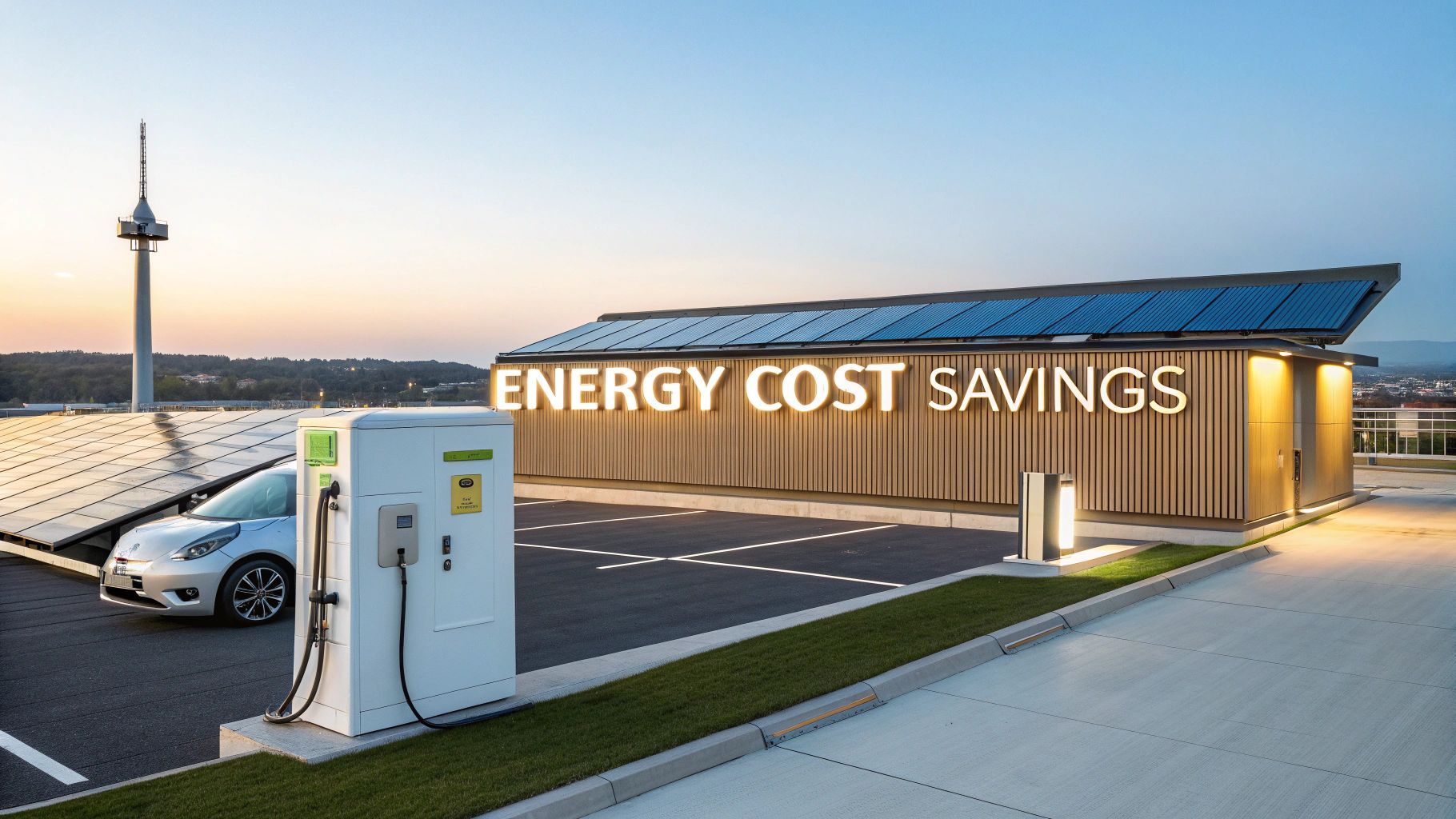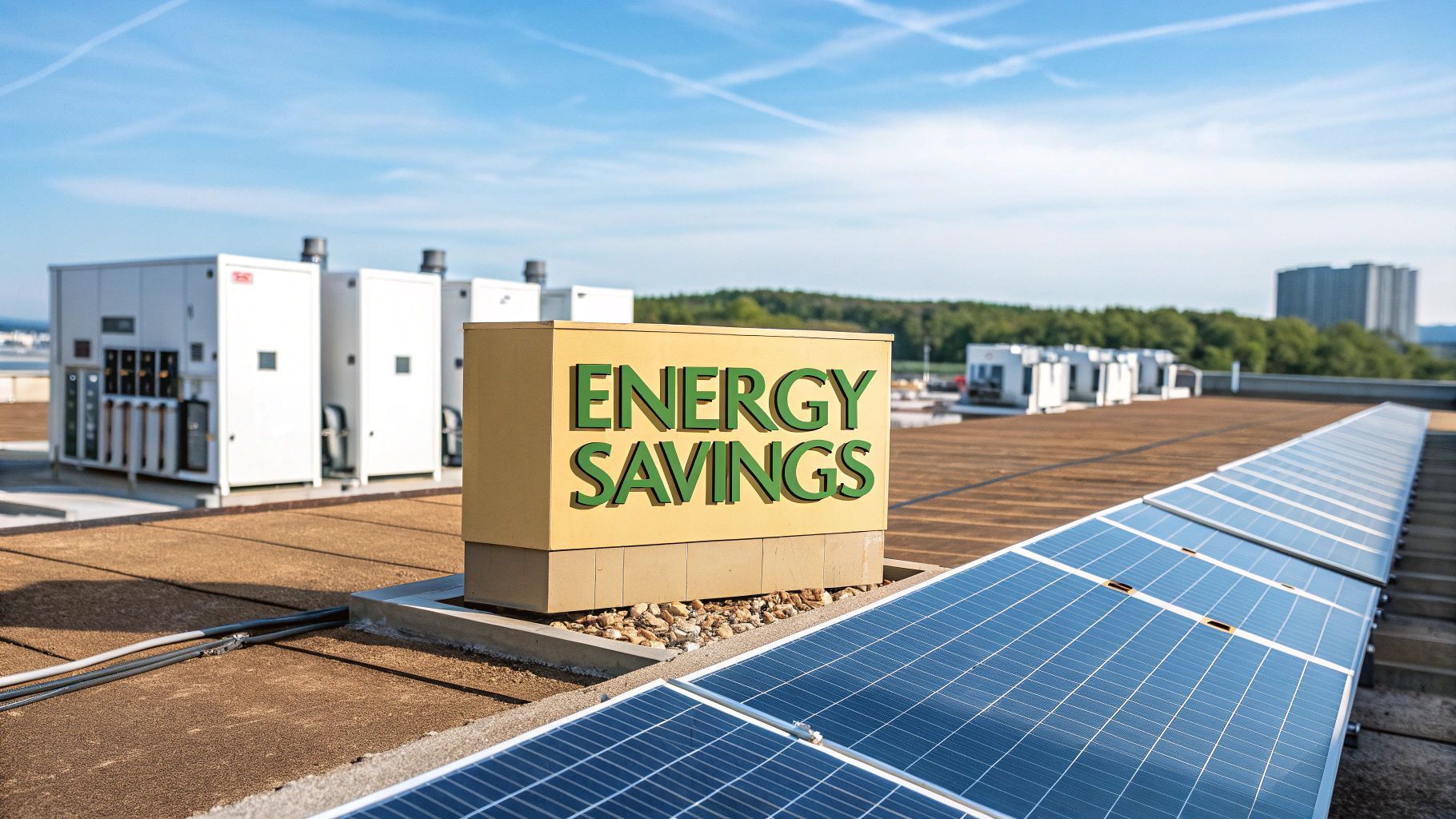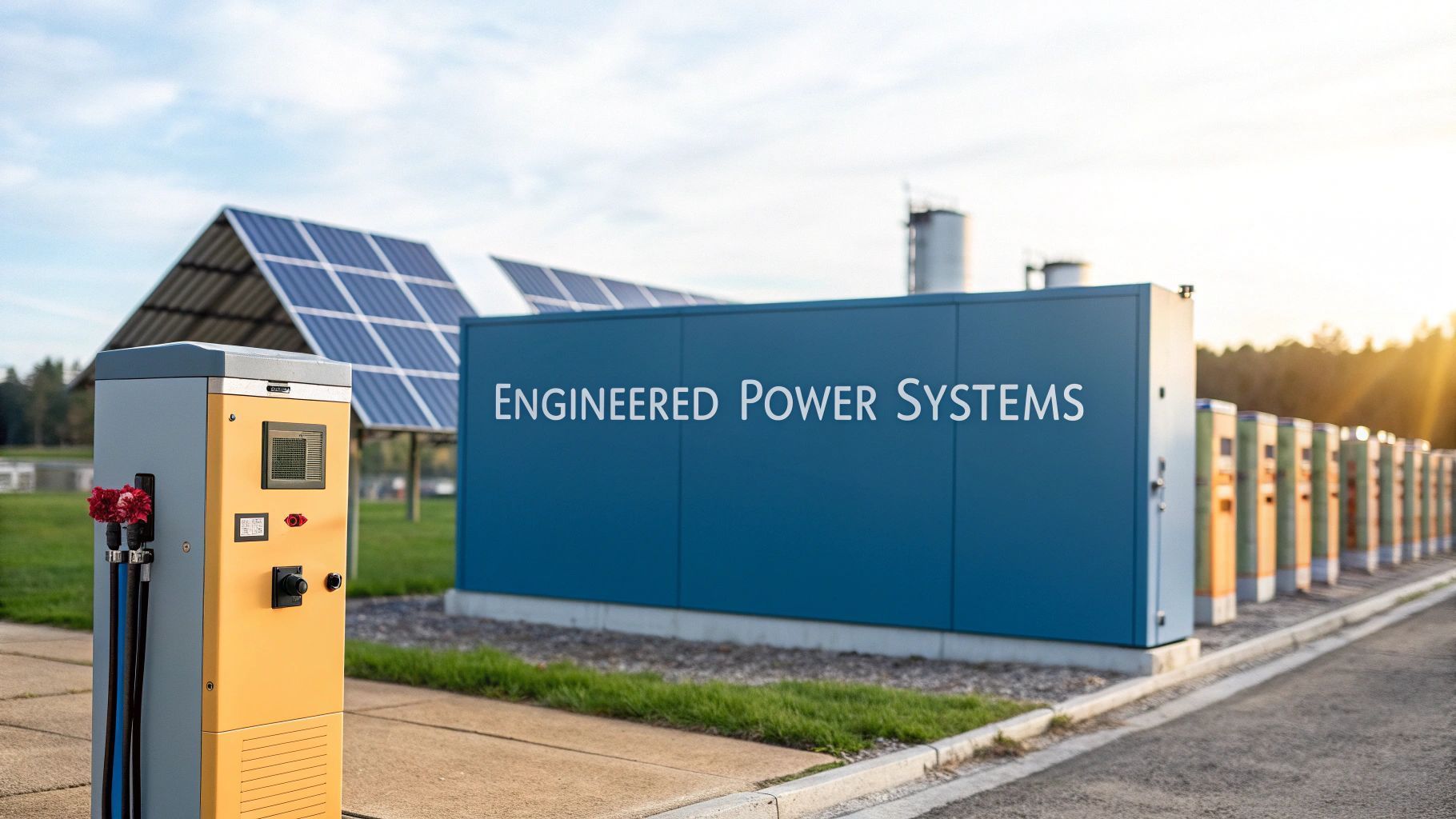Battery Energy Storage Systems in the UK: Powering a Greener Future
Battery energy storage systems in the UK are quickly becoming the backbone of the country's move to clean energy. These systems, which are essentially giant rechargeable batteries, are crucial for balancing the national grid as we bring more intermittent renewables online. They are the missing piece of the puzzle for a stable, low-carbon power supply for everything from our homes to rapid EV charging.
Why Battery Storage Is Powering the UK's Energy Future

The UK is in the middle of a quiet but powerful energy revolution and at its heart are battery energy storage systems (BESS). It helps to think of them as the nation’s power banks, storing electricity when it’s plentiful and releasing it precisely when we need it most. This unique capability makes them indispensable for a modern, green electricity network.
As the country continues its shift away from fossil fuels our reliance on wind and solar power grows. BESS solves the biggest headache that comes with renewables: their intermittency. They soak up all that excess energy on a windy afternoon or a bright sunny morning and then deploy it during calm evenings or cloudy days, ensuring a constant, reliable flow of power.
This stabilising effect is vital for much more than just keeping the lights on. It’s the enabling technology that unlocks massive expansion in other parts of the green economy, particularly the rollout of electric vehicles and distributed energy resources.
Supporting the Electric Vehicle Transition
The switch to EVs is putting immense pressure on our local grid infrastructure. Installing a hub for rapid EV charging can easily overwhelm a constrained grid connection, creating bottlenecks and forcing costly, time-consuming upgrades. This is where the synergy between EV charging and batteries becomes so important.
By co-locating a battery system with an EV charging hub operators can create a powerful energy buffer. The battery can charge slowly during off-peak hours and then discharge its stored energy to rapidly charge multiple vehicles at once, avoiding strain on the grid.
This isn't just a theoretical idea; it's a practical solution being rolled out across the UK right now. It allows for the widespread growth of rapid and even mobile EV charging, especially in areas where the grid just can’t cope on its own. It is a cornerstone of combining on-site renewables, EV charging and batteries into a cohesive system.
A Market Experiencing Major Growth
The importance of BESS is reflected in its extraordinary market growth. Since 2020, the UK's operational battery energy storage capacity has shot up by a remarkable 509% , climbing from 1,128 MW in 2020 to an expected 6,872 MW in 2025. This explosion in capacity shows just how fast grid-scale batteries are being deployed to support the ever-increasing share of renewable energy on our grid. You can discover more about the UK battery market growth and what it means for the coming years.
This boom underscores how battery energy storage systems in the UK are no longer a niche concept. They have become a central pillar of our national energy strategy—the unsung heroes powering a more resilient, flexible and sustainable Britain.
How Battery Storage Makes Green Energy Reliable
The biggest challenge for renewables like wind and solar is pretty obvious: the sun doesn't always shine and the wind doesn't always blow. This natural variability, or intermittency, is a major hurdle for a national grid that needs a constant, steady supply of power every second of the day.
This is exactly where battery energy storage systems in the UK come in, offering a simple yet powerful fix.
Think of a large-scale battery system as a giant energy reservoir for the country. On a windy afternoon or a bright sunny morning our renewable sources often generate more power than we're actually using. Instead of letting that precious green energy go to waste, battery systems capture and save it for later.
They then feed this stored electricity back into the grid precisely when it's needed most. That might be during the evening peak when millions of us get home and turn on the lights or on a calm, overcast day when renewable generation naturally drops off. This simple cycle of charging and discharging transforms intermittent green energy into a reliable, on-demand power source.
Providing Critical Grid Balancing Services
This ability to rapidly store and release electricity allows battery storage to play another vital role: grid balancing . To run safely and avoid blackouts the National Grid has to maintain a perfectly stable frequency, which is around 50 Hz here in the UK. Any deviation, up or down, can cause serious problems.
In the past, this balancing act was left to fossil-fuel 'peaker' plants. These could be fired up quickly to meet a sudden jump in demand but they're expensive, inefficient and dirty. Today, grid-scale batteries provide a much cleaner, faster and more effective alternative.
Batteries can react to grid fluctuations in milliseconds, either injecting power to boost frequency or absorbing it to bring it down. This near-instant response is a game-changer for modern grid management, ensuring stability even as we add more and more renewables to the mix. It's easy to see how these solutions are fundamental to improving grid stability and resilience across the UK.
By smoothing out the peaks and troughs of renewable generation, battery storage acts as a shock absorber for the grid. This function reduces our reliance on fossil fuels for backup power and enables a much higher penetration of renewables.
Enabling a Decentralised Energy Future
Beyond balancing the national grid, battery storage is also unlocking a more localised, distributed energy system. It’s the key to combining on-site renewables with other assets like EV charging infrastructure. A business, for example, could store excess solar power generated during the day and use it to run its operations or charge its electric vehicle fleet overnight.
This chart shows just how fast battery storage is growing worldwide, a trend the UK is at the forefront of.
The sharp upward curve speaks for itself, highlighting the rapid deployment of this technology as countries race to decarbonise their grids and bolster energy security.
This ability to store and manage power locally is especially important for sites with a weak or constrained grid connection. By installing a battery system you can effectively create a local microgrid that's less reliant on the central network. This paves the way for a more resilient and flexible energy future, unlocking opportunities for services like mobile EV charging and the development of large rapid EV charging hubs without needing expensive and time-consuming grid upgrades.
Powering the UK's EV Revolution
The UK's shift to electric vehicles is picking up serious speed but this progress brings a major challenge for our national grid. The sudden, intense demand from multiple cars needing a fast top-up can easily overwhelm local electricity networks, especially at peak times. It’s a huge bottleneck holding back widespread EV adoption.
Putting in rows of rapid chargers at a motorway service station or a busy city depot isn't as simple as just plugging them in. The power needed for rapid EV charging is immense. Just a handful of vehicles charging at once can demand more electricity than the local grid connection was ever built to supply.
The traditional answer has always been a painfully slow and expensive grid upgrade, which often means digging up roads to lay bigger cables. This can drag on for months, sometimes years, and the cost can kill the business case for many potential charging hubs, stalling the rollout of essential infrastructure.
The Smart Solution for Constrained Grid Connections
This is where the powerful partnership between EV charging and batteries really shines. By installing battery energy storage systems alongside charging hubs, operators can completely sidestep the limits of a weak grid connection. The battery acts as a critical on-site energy buffer, fundamentally changing how power is managed.
Instead of pulling massive spikes of power directly from the grid every time a car plugs in, the hub draws from its own dedicated battery. The battery itself can be gently topped up from the grid during off-peak hours—like overnight—when demand is low and electricity is cheap. This slow ‘trickle charge’ puts almost no strain on the local network.
When the morning rush hits and drivers need that fast charge, the fully charged battery is ready to deliver its stored power, servicing multiple vehicles at high speed without ever bothering the grid. It’s a smart approach that makes it possible to deploy large-scale, rapid EV charging facilities almost anywhere, regardless of the existing grid capacity.
This infographic shows how a battery acts as a power buffer, enabling rapid EV charging even on a weak grid connection.

As you can see, the battery system absorbs energy slowly over time and then delivers it in powerful bursts when needed, shielding the local grid from sharp spikes in demand.
Real-World Applications Across the UK
This combination of EV charging and battery storage is already being put to work across the UK, opening up new possibilities for a truly flexible energy network. We are seeing these solutions solve real problems in a variety of settings.
- Motorway Services: These prime locations often have surprisingly weak grid connections. A BESS allows them to offer the dozens of rapid charging bays needed to serve long-distance travellers.
- Urban Charging Hubs: In city centres where grid upgrades are disruptive and expensive, batteries enable the creation of much-needed public charging facilities without causing chaos.
- Commercial Fleet Depots: Logistics companies can charge their entire electric fleet overnight using cheaper off-peak energy stored in an on-site battery, drastically reducing their operating costs.
The synergy between batteries and EV infrastructure is not just a workaround; it's a superior model. It reduces grid stress, lowers operating costs by enabling energy arbitrage and accelerates the UK's journey to net zero.
This technology also paves the way for clever solutions like mobile EV charging . Imagine a large battery mounted on a vehicle that can be deployed to provide rapid charging at events, in remote locations or to rescue stranded motorists—all using power stored when it was cheapest.
To better understand the impact, here’s a quick comparison of how BESS-integrated systems stack up against traditional approaches to common EV charging challenges.
BESS Solutions for UK EV Charging Challenges
| EV Charging Challenge | Traditional Solution | BESS-Integrated Solution |
|---|---|---|
| Grid Congestion | Expensive and slow grid reinforcement, often taking years. | Battery stores off-peak energy, delivering it during peak times to avoid grid strain. |
| High Energy Costs | Forced to buy electricity at peak prices when demand is high. | "Energy arbitrage" - buy and store cheap off-peak electricity for use during expensive peak hours. |
| Location Constraints | Charging hubs are limited to areas with strong existing grid connections. | Enables rapid charging deployment anywhere, regardless of grid capacity. |
| Slow Rollout | Delays caused by planning permission and construction for grid upgrades. | Faster to deploy as it bypasses the need for major grid intervention. |
The benefits are clear. BESS technology makes the EV charging network more resilient, cost-effective and scalable.
This is a fundamental shift in how we approach vehicle refuelling. To see how these integrated systems are already making a difference, you can learn more about how battery energy storage systems are powering the UK's EV revolution and enabling a smarter, more flexible grid. When you combine on-site renewables like solar panels with a BESS and EV chargers, businesses can create self-sufficient energy ecosystems that offer clean, low-cost power for transport.
The UK Market and Investment Landscape

The UK has jumped to the front of the pack in Europe for battery energy storage, creating a hugely attractive market for investors. This isn't just by chance. It's the result of clear government goals, smart regulations and the undeniable need to bring our national grid into the 21st century.
You've got a whole ecosystem of players shaping the industry now. Specialist developers are out there scouting prime locations and handling the planning permissions while large-scale operators manage entire portfolios of grid-scale batteries. Add in the technology providers and financiers and you have all the ingredients for the boom in projects we’re seeing across the country.
You can feel the commercial confidence in the air. In the first half of 2025 the market saw a massive 78% year-on-year increase in new grid-connected capacity. At the same time project submissions for planning approval shot up by 25% compared to the same period in 2024, showing there's a very healthy pipeline of work still to come. You can get the full story on this soaring UK battery storage activity to see just where the market is heading.
Favourable Policies and Regulatory Support
The UK government gets it: battery energy storage systems aren't just a nice-to-have, they're essential for hitting our net-zero targets. As a result policies have been put in place to clear hurdles and encourage investment, giving the sector a stable foundation for growth.
One of the biggest game-changers has been sorting out the planning rules. In England and Wales battery projects are now handled by local planning authorities, which massively simplifies what used to be a tangled mess of red tape. That clarity gives developers a much clearer runway from proposal to getting a site operational.
On top of that, the energy regulator, Ofgem, is working hard to make sure storage is properly integrated into the electricity market. They're creating frameworks to ensure batteries can get paid for the full range of jobs they do—from trading energy to keeping the grid balanced.
A supportive regulatory environment is the bedrock of investor confidence. By providing clear rules and valuing the grid services that batteries offer, the UK has created one of the most attractive markets for energy storage investment in the world.
This hands-on approach sends a clear signal that the UK is serious about building a modern, flexible energy system with storage right at its heart.
The Business Models Driving Investment
At the end of the day, it's the real-world revenue streams and solid business models that are pulling serious capital into the UK BESS sector. Investors aren't just backing a green dream; they're funding a commercially sound, vital piece of national infrastructure.
These models are all about capturing value from the ups and downs of a modern energy market.
- Energy Arbitrage: This is the classic "buy low, sell high" model. It’s all about charging the battery when electricity is cheap (like overnight or on a really windy day) and selling that power back to the grid when prices peak.
- Ancillary Services: National Grid pays for services that keep the system stable, second by second. Grid-scale batteries are incredibly fast and precise, making them perfect for jobs like frequency control, which creates a steady, reliable income.
- Co-location Benefits: Pairing batteries with other assets is where things get really clever. Stick a BESS next to a solar farm and you can sell solar power long after the sun has set. Or, combine on-site renewables, EV charging and batteries to deliver rapid EV charging where the grid is too weak, opening up two revenue streams from one site.
This ability to "stack" different income sources makes battery energy storage systems in the UK a uniquely flexible and appealing asset. Because they can do so many jobs at once—from propping up renewables to enabling distributed energy networks—they offer multiple paths to a return on investment, fuelling the market's incredible momentum.
Making the Numbers Work for Battery Storage
Beyond the technical wizardry, what really makes battery energy storage systems in the UK a smart investment? It all comes down to the financial mechanics that turn these grid-stabilising assets into powerful revenue generators. The business case is built on a simple but incredibly effective principle: capturing value from the ups and downs of the UK’s electricity market.
At its most basic level this means playing the energy arbitrage game. Think of it as the energy market's version of "buy low, sell high." Battery operators charge up their systems when electricity is cheap—usually overnight or on exceptionally windy and sunny days when renewables are flooding the grid. They then sell that stored power back when demand peaks and prices soar, like during the early evening rush. That price spread creates a direct and straightforward income stream.
Capitalising on Market Swings
The rapid growth of renewables is making UK electricity prices more volatile and for battery owners that's fantastic news. The bigger the price swings, the greater the opportunity for arbitrage. This dynamic is a huge driver behind the commercial success of battery energy storage systems uk .
The very thing that used to be a grid management headache—the variability of renewable energy—is now a prime financial opportunity for battery assets. They thrive on the intermittency they were built to solve.
Take June 2025 as an example. Battery energy storage systems in Great Britain saw a surge in revenue, earning around £76,000 per MW per year —a 20% jump from the previous month. This boost was directly tied to an increase in intraday price volatility. You can dive deeper into these recent revenue benchmarks to see how market conditions are creating fresh opportunities. Of course, a key part of this is knowing how to measure profitability, which starts with learning how to calculate return on investment.
More Than Just Arbitrage: Ancillary Services and Stacked Revenues
But arbitrage is just one piece of the puzzle. The real magic of battery energy storage systems lies in their ability to "stack" multiple revenue streams by performing different jobs for the grid, often at the same time. One of the most important is providing ancillary services to National Grid.
These are the essential background services that keep our electricity network stable and secure and batteries are perfectly suited for the role because they're incredibly fast and precise.
Key ancillary services include:
- Frequency Response: Batteries can react in milliseconds to stabilise the grid's frequency. They inject or absorb power instantly to keep the lights on and National Grid values this rapid response very highly.
- Capacity Market: Operators can get paid just for having their battery capacity available to the grid. It acts as a reliable backup during times of high stress on the system.
By combining the money made from energy trading with payments for these vital grid services operators build a much more robust and diversified business model. This multi-layered approach makes BESS a commercially sound cornerstone of the modern energy market and a compelling proposition for anyone looking to invest in the UK's transition to a flexible, distributed energy system.
The Future of Energy Storage in Britain
Looking ahead, the role of battery energy storage systems in the UK isn't just about growing; it's about evolving. We're moving beyond simple, short-term grid balancing and starting to tackle the much bigger energy challenges on the horizon. The whole sector is innovating at a dizzying pace, driven by one simple truth: to hit our net-zero targets we need a smarter, more resilient and more decentralised electricity network.
One of the biggest shifts we're seeing is the push for longer-duration storage. Today's systems are brilliant at smoothing out those rapid, minute-by-minute bumps in supply and demand. The next frontier? Solving seasonal shifts. Think about it: storing the huge surplus of solar power we generate in the summer to see us through the darker, less windy months of winter. Getting there will mean exploring new battery chemistries and entirely new technologies built for long-haul stability and affordability.
The Rise of Virtual Power Plants
Another trend that’s really picking up steam is the way we’re integrating batteries with other local energy sources. Picture this: thousands of individual assets—from rooftop solar panels and commercial battery systems to your neighbour's EV charging point—all connected and intelligently managed by a single piece of software. This network can be grouped together to act like a single, massive power source. We call this a virtual power plant (VPP).
A virtual power plant can deliver the same grid-stabilising services as a traditional power station but with far more flexibility and without the carbon footprint. By coordinating assets that are already out there it unlocks immense value from our existing infrastructure.
These intelligent networks can respond as a collective to signals from the grid, either dialling back demand or exporting stored energy to keep everything stable. It’s a fundamental shift, turning consumers and businesses into active players in the energy market. This idea is central to building an energy system fit for the future and you can explore why this technology is built for 2030 and beyond to see just how these systems are engineered to meet tomorrow’s challenges.
Optimisation Through Advanced Software
The engine driving all of this is the growing sophistication of artificial intelligence and advanced control software. To get the most out of a battery system it needs to make thousands of complex calls every single day: when to charge, when to discharge and which energy market offers the best return at that exact moment. AI algorithms can chew through huge datasets—from weather forecasts to real-time market prices—to make these decisions with a speed and accuracy no human could match.
This software is the key to ensuring every single kilowatt-hour of stored energy is put to its best use. That might mean supporting a bank of rapid EV chargers , providing essential services back to the grid or simply making the most of arbitrage opportunities. It is this digital intelligence that will truly unlock the full potential of battery energy storage systems in the UK .
Ultimately, the grid of the future won't be built on hardware alone. It will be a dynamic, intelligent network where battery storage, renewables and smart software all work in harmony. This integration is essential if we're going to enhance Britain's energy security, hit our climate targets and power the clean, electrified economy of tomorrow.
Frequently Asked Questions
Getting your head around battery energy storage systems in the UK can bring up a lot of questions. We’ve put together some clear, straightforward answers to the most common queries to help you understand this vital technology.
What Is the Main Role of Grid Scale Batteries in the UK?
At their core, the main job of grid-scale batteries is to bring flexibility and stability to our national electricity grid. This has become crucial as the UK leans more on renewable energy like wind and solar which, as we know, don't generate power around the clock.
Batteries act as a massive energy buffer. They soak up excess energy when generation is high and power is cheap, then push it back to the grid when demand spikes or the wind stops blowing. This constant balancing act helps keep the grid's frequency stable, reduces our need for polluting fossil fuel backup plants and ultimately supports a cleaner, more reliable energy system for everyone.
How Do Batteries Help with EV Charging from Constrained Grid Connections?
It's a common problem: many perfect spots for EV charging hubs, like motorway service stations, just don't have the grid capacity. Trying to install a bank of rapid chargers would easily overload the local connection, leading to eye-wateringly expensive and slow grid upgrades.
This is where a battery energy storage system (BESS) provides an elegant solution. It works like an on-site energy reservoir, 'trickle charging' itself from the grid when demand is low. Then, when a rush of EVs plug in at once they draw power straight from the fully-charged battery, not from the fragile grid. This makes it possible to roll out rapid EV charging infrastructure exactly where it's needed most.
By decoupling the act of charging a vehicle from the immediate grid demand BESS allows for powerful charging hubs to be built without needing disruptive and expensive grid reinforcement.
This approach is also the key that unlocks advanced solutions like mobile EV charging , allowing stored power to be delivered directly to vehicles, wherever they are.
Are Battery Energy Storage Systems a Profitable Investment in the UK?
Yes, absolutely. Battery energy storage systems are proving to be an increasingly profitable investment in the UK, mainly because they can tap into several different revenue streams. For starters, operators can perform 'energy arbitrage'—a simple concept of buying electricity from the grid when prices are low and selling it back when they're high.
They also generate reliable income by providing essential 'ancillary services' to the National Grid, such as frequency response, which helps keep the entire system running smoothly. The growing volatility in electricity prices, driven by the rise of renewables and the expansion of distributed energy networks, is only creating more lucrative opportunities.
This makes BESS a key asset in the UK's modern energy market. When you combine batteries with on-site renewables and EV charging , you can create powerful, self-sufficient energy hubs that generate income from multiple angles.
At ZPN Energy , we design and deliver fully integrated energy management and storage solutions that power the future. From grid-scale batteries to rapid EV charging infrastructure, our UK-developed technology provides the resilience and flexibility your business needs to thrive in a low-carbon world. Discover our advanced solutions at https://www.zpnenergy.com.








